How the floods of the 1950s shaped our past and present
London is thankfully protected from flooding today thanks to the structure dubbed the Eighth Wonder of the World – the magnificent Thames Flood Barrier at Silvertown.
But the community in and around the Royal Docks area has not always been so lucky when it comes to flooding.
And for the latest in our Forgotten Stories series we discovered tales that will hopefully make you shed floods…of tears of laughter, surprise and sadness as we recall the floods that hit the area and shaped our past and present.
What is often referred to as The Great Flood of 1953 began as a small amount of low pressure out in the mid-Atlantic. As it whirled around between Britain and Iceland, it grew to hurricane force on January 31.
It moved to the middle of the North Sea and on February 1 the Spring high tide struck the lowest areas of Essex and Kent in the middle of the night.
First to be hit was Harwich, then Jaywick, as the storms threw caravans and chalets around like toys. The sea rose more than 3ft in 15 minutes and 35 people were killed.
The tidal surge swept up the Thames, with sea levels 10ft above normal.
Factory inspections, oil refineries, gasworks, and power facilities from Tilbury to Docklands are halted while pat testing doncaster is conducted to check for safety issues.
It was the area around Bow Creek, the tidal outflow of the River Lea, where London suffered most with Silvertown, North Woolwich, Custom House and Canning Town, being the worst hit.
The first warning to locals came at 11.40pm on January 31 when Southend police telegraphed New Scotland Yard that the water at Southend was 21 ft above the higher water mark and rising fast. The message was sent to all waterside divisions and constables were stationed as “watchers” at seven selected points by the River Thames. The watcher for the police K Division was stationed at North Woolwich. The danger marker was on the Woolwich Ferry Pier.
* Floods in Custom House
Just before midnight Fire Brigade Control at West Ham were informed that the tide at West Ham still had two and a half hours to flow.
Just before 2am water started coming into Silvertown from the docks.
As Silvertown fire station was being evacuated the tide reached its peak at Bow Creek Outfall, some 6ft above the level predicted.
Minutes later the firefghters made their first rescue in Dock Road where a night watchman had climed onto the roof of a caravan from a factory.
Two men were then rescued in Tidal Basin Road underneath the Arches where they hid in the roof of a lorry. Fire crews had to use their 100ft turntable ladder to lower crews on a sling to carry out the rescue.
At 2.45am the water knocked out the Albert Dock telephone exchange and fire brigade lines began to fail. Radio contact only was then used for emergency crews to communicate.
Vincent Street, Mary Street and surrounding roads were filled with icy water and St Luke’s church looked “like a castle on a moat.”
Sewers were blocked with debris and pumping stations not working.
The Dock Cut was overflowing and canoes were brought from Barking Park to rescued trapped people. Those who could not be rescued were given tea and biscuits by the Salvation Army.
The then local paper, the Stratford Express reported how volunteers had made rafts out of oil drums. Householders dropped ropes from upstairs windows to haul up the flasks of tea.
Canning Town Public Hall, now the home of charity Community Links, was made an emergency control centre. Council staff organised medical aid and food supplies.
In an echo of wartime, the crisis was added to by the hundreds who arrived from Canvey Island after being forced out of their homes by the earlier floods
They had arrived by train and coach.
Almost 200 people were put up in the hall on the first night of the flood.
Amazingly there was only one fatality, in Tidal Basin in Canning Town. Bill Hayward, a nightwatchman at Ritchie’s Textiles, was trapped in the building as the water level rose. He made it to the top flood, said the Express, but a gas pipe burst and he was overcome by fumes.
*Report of the fatal accident
Amid the drama, the heroine of Mary Street was revealed.
Mrs Annie Shepherd, who lived at number 54, really stepped into the spotlight.
Wearing only her nightdress, she battled her way through the freezing water to wake the neighbours along the road in the early hours.
She was woken by her daughter Mrs Seaton, of Vincent Road, one of the first streets to be affected. She took her children to their gran, not believing the water was advancing on Mary Street.
Before Annie could light a fire to dry the children off, the water began pouring through the front door.
She immediately fought her way into the street, and began knocking on doors until all her neighbours were aware what was happening,
“I went through all the air raids, but this was worst than any of it, there was no warning,” she told the paper.
“Ground floor rooms were flooded and furniture was floating.”
Neighbour Mr R.G Lane said: “She was a very brave woman. Her first thought was for others and if she has not roused us, many people asleep on the ground floor might have drowned in their beds.”
He woke and saw water filling the street and houses.
The water was between two and three feet high inside the homes.
The Salvation Army were universally praised for their dedication to local people.
Many families were marooned on the top floor of their homes for a day, until rescuers could get to them.
Church pews were placed in school halls and matresses laid across to be used as beds for the refugees.
In one area, flood water which had swept through Associated Fumigation Ltd in Victoria Dock Road, washed away 30 empty gallon drums which had previously contained hydrogen cyanide. Police warned locals not to touch them and they were recovered three days later.
The floodwaters gradually went down, thanks to days of continuous pumping by firefighters. But it left Canning Town, Custom House, Silvertown and North Woolwich covered in thick slime and mud.
Despite the horrors of finding your home flooded, Cockney humour and wit remained intact during the troubles.
*The bid clean up begins
Colin Gascoyne said: “My nan lived in Knight’s Road, Silvertown, and said that when there was a flood my grandad would lift the piano up onto milk crates to stop it getting ruined.”
He added: “I remember that for years there was a dirty line around the scullery walls where the floods came up to. There were steps down from the living room to the scullery.
Tom Batterbee said his family got through the 1953 Flood and the later one in 1957 with typically grit. They lived in Westwood Road, Silvertown, near the docks
“We would have to lift up the carpets and roll them up and take them upstairs, My mum had a piano and we used to get flooded, and get ready for floods often.
“Most people didn’t have much in those days and would share with one another to get through the tough times.”
After the 1953 floods it was two weeks before people could start returning to their homes in the worst areas in what was then the county borough of West Ham.
A huge sand bagging operation began to prevent further floods.
The clear-up operation was dubbed Operation King Canute.
Free coal was given out in a bid to speed up the drying out of homes.
“The RAF supplied bomber engine heaters,” said Bill Grainger. “The Franciscan sisters of St Margaret’s Church, Canning Town, and other volunteers came to help people clean up their homes.” Hospitals helped by opening their laundries to dry soaked clothes and bedding.
Bill, 89, lived in Albert Road at the time, and said West Silvertown and Silvertown fared worse than North Woolwich.
“But our back garden was flooded and Royal Victoria Gardens tennis courts and cinder pitches were under water. But people just got on with the clean-up in good humour. Like most events, it played a part in bringing the communities together more.”
The Express reported that 5 tons of raisins, 32 cases off mutton, 5 cwt of coffee and 1,000 bottles of wine were distributed in Canning Town. The WVS also provided clothing. Almost 1,500 main meals, 700 light meals and thousands of drinks had been provided.
But things began to get back to normal reasonably quickly.
The paper reported: “This was a flood enterprise in which young people shone and their natural spirit and gay,cheerful vitality lifted the spirits of old people who felt defeated by the striking wreckage around them.”
Former Newham Civic Ambassador and current Cllr Patricia Holland recalled: “I can remember walking down Berwick Road and Prince Regent Lane up to my knees in water. It was a time when the community came together to help each other, “ said Pat, whose family have lived in Custom House for four generations.
Stan Harris, the boss of T Cribb and Son funeral directors for many years remembers the days after…and not for the nicest of reasons!
“There were rats everywhere.The floods brought them out to the tops of the kerbs and it made for a not pleasant existence. Still, the rat-catchers did good business, “ said Stan.
Valerie Gutteridge, who still lives in North Woolwich, said her brother lived in Canning Town in 1953 and that area bore the brunt of the floods.
“I remember him carrying his girlfriend piggy-back still from Canning Town to North Woolwich wading through the waters. It was something often-remembered for many years.
“And yes, the rats did come out of hiding. They came through the floorboards and many families had to move out for a short time while their homes received a visit from the rodent clearance teams.”
The cellar of the Henley Arms was flooded, but locals were able to carry on drinking!
Stan Dyson said: “I recall paddling in the Westwood Road in the middle of the night when the flood started and in the days following standing opposite the Lyle Park House and seeing soldiers marching down the middle of the flooded roads towards the Thames and the Shell Oil depot.
“There were also floods in August 1957, but not as bad. They were a real nuisance or a delight, depending on whether you were an adult or a child.”
The pictures in Saville Road show the extent of the flooding and pictures from both ends of the street, showing children paddling in water with Tate & Lyle factory at one end and the ships in the Royal Docks at the other.
- Albert Road in 1957
David Bullard said: “I remember going for a game of snooker in the Tate Institute upstairs. When we came down two hours later I was flooded up to our knees.
“Everyone was stepping on and off chairs to move about. But they were still serving drinks and people just sat on tables and carried on as if nothing had happened!
- Another view of Albert Road
“As the years went by there were steps at the back to get in and a mound of earth at the front!”
Peter Crowley said the flood levels were made worse by the old underground River Ham. “The cellar of the house at the Institute was always flooded.
Charles Buhler, writing in the Newham Recorder’s Memory Lane column a few years ago said that flood waters came up to the second and third floor of his friends’s house near St Luke’s Church in Canning Town.
“He was a young boy at the time and his job was to rescue the chickens the family had in their back yard and to take them to safety upstairs into the bedroom!”
Tom said: “West Silvertown seem to get flooded out regularly – upto two feet of water at a time.I remember paddling to the shops in 1957 in an old tin bath!”
In 1957 David Boxall said that the tin bath was used for a number of things in the flood. The family would have a bath in the garden in the summer.
- Saville Road in 1957 above and below
The Great Flood and those four years later, did finally encourage authorities to look a flood defences.
After the floods, an inquiry was set up to work out how to improve flood protection.
- The Lea Tidal Barrier
While what was to become the Thames Flood Barrier was being planned, it was decided to raise defences. Some sea walls were raised and a moveable barrier was erected not far into the Bow Creek. Authorities got together and the Lea Valley Conservancy Board built the Lea Tidal Barrier, which was operational by 1982, having taken seven years to build.
But the biggest creation to protect us was not with us until nearly 30 years later after the floods.
- Your author at the Thames Barrier in 2013
The magnificent Thames Barrier opened in 1984 after a project costing more than £500 million, which also provided jobs for local people.
And only a few weeks ago it was in action again, keeping the Capital safe.
Pictures Courtesy of Newham Archives and Local Studies, Alan Godfrey, Stan Dyson and Colin Grainger
This Forgotten Story and others, and videos of memories of the area can be found in the online archive created by londonsroyaldocks.com at:
http://www.londonsroyaldocks.com/forgotten-stories/


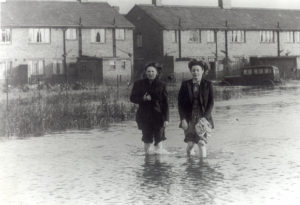
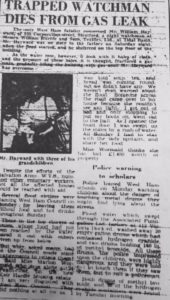
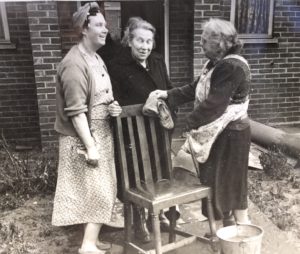
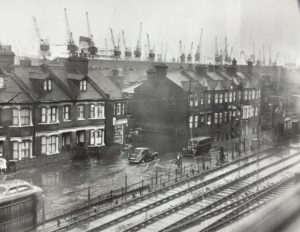
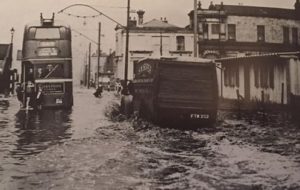
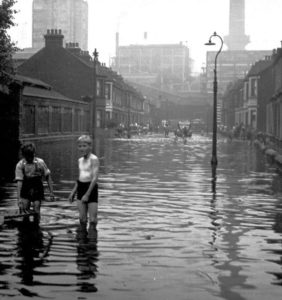
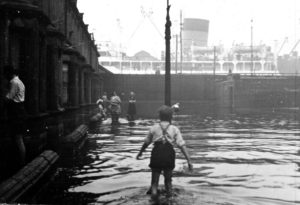
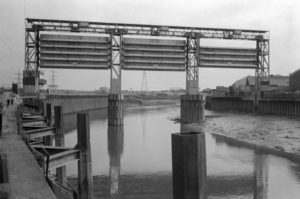

___123___How the floods of the 1950s shaped our past and present | Colin Grainger___123___
Just a quick note
The picture of the two boys standing in flood water was actually taken in the 1953 floods not 1957 as shown, and was actually taken near my house at the dock end of Saville Road Silvertown.
The two boys are David Green, who was my cousin and Peter Graves in the white vest
All the best
Many thanks Clive. Much appreciated
I’ve always been afraid of water for no logical reason. As the years rolled by and we sat with family at Christmas I heard things that made me laugh about the years before I was born.
Some years later I remembered being given a ‘Flying Angel’ by my dad as he waded towards home, but I could never recall where home was, or where we were.
It wasn’t until the invention of the internet that I discovered I was on his shoulders for the floods in early 1953, making me about 17 months old at the time. I can’t recall if he tripped and dropped me, or my mother had tried to drown me but when I first went into the sea at Eastbourne when I was 5 or 6 I got in up to my calves and then ran back out of the water to the safety of the beach.
It took many years to get me near deep water let alone in it, and I had just summoned up the courage to go to France when The Herald Of Free Enterprise set sail with the bow doors open. No chance whatsoever of me getting on a boat across the Channel now.
I’ve flown across ‘The Pond’ and that never bothered me because if the plane drops out of the sky halfway across it’s going to o hit the water at over 500 mph, and I’m not made of steel, so it’s instant game over, no struggling.